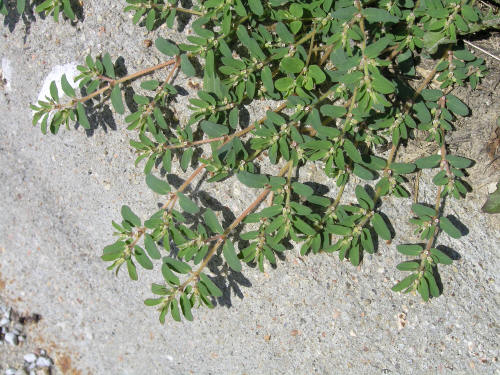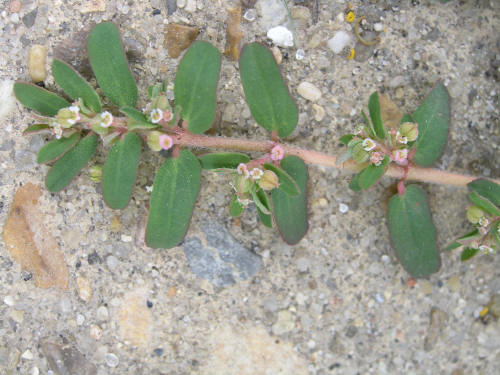Spreading Sandmat
Euphorbia humistrata Engelm. x A. Gray
[also called Chamaesyce humistrata (Engelm. x A. Gray) Small]
Spurge Family (Euphorbiaceae)

▲ Spreading sandmat (greener, non-spotted leaves) growing with spotted spurge (more purplish and spotted leaves) in a pavement crack

▲ young plant
▲ mature, flowering plant about 18 inches in diameter

▲ ▼ flowering stems (lower photo has some leaves with purple spots)


▲ ▼ flower and fruit detail, showing the capsules hanging out of the side of the split cyathia (flower)

Spreading Sandmat:
- Has larger leaves than Prostrate Spurge, with a few hairs on both sides of the leaves; may or may not have purple spot; leaves usually green or tan-green, not pink or reddish
- Stems usually green or tan-green, not pink or reddish, and stems may root at the nodes
- Capsule lightly covered with incurved hairs; style is split about half way; cyathia (flower) is split on one side
- Cyathia (flower) is split on one side and capsule hangs off to that side-- this differs from the less split cyathia of Prostrate Spurge
- Similar Spotted Spurge has capsules are evenly covered with hair without pronounced angle hair; styles are divided about 1/4 to 1/3 their length, with pink bulb-like tips, and always has spots on its leaves
- All three prostrate-growing spurges (prostrate, spotted and spreading sandmat) are common in southwest Missouri and are best identified by looking at leaf, flower and fruit characteristics ; another prostrate-growing spurge, Creeping Sandmat, has smaller, oval to almost rounded, hairless leaves and fruit
- Another occasionally found prostrate-growing spurge is Slimseed Sandmat, which has oval leaves with uneven leaf bases and teeth on the margins and hairy leaves and stems; its capsule is covered with soft hairs, particular the basal portion; the style is short, and not split; the cyathia (flowers) may have tiny white, petal-like appendages; this plant is more common south and west of Missouri